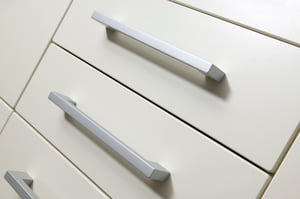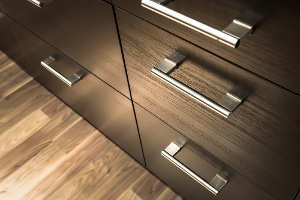School labs can take a beating whether they're designed for chemistry, biology, physics, art or woodworking.
Every day they face collisions with endless packs, shoes, tools, chemicals and instruments. Choosing a material that can take a beating is no easy task. You need something durable and practical for daily classroom use.
That leads us to steel and wood. Both are popular options for school cabinets since lab instructors often love how effectively they can hold equipment like microscopes and machinery.
But, which is better: Steel vs. wood cabinetry? Below we’ll take a look at their pros and cons and help you determine which will work best for your school lab build or remodel.
Pros and Cons: Steel Cabinets
Steel is iron forged with carbon, usually containing less than 2% carbon and 1% manganese. Steel also contains trace amounts of sulphur, oxygen, phosphorus and silicon.
contains trace amounts of sulphur, oxygen, phosphorus and silicon.
There are different variations of steel cabinets, including stainless steel. Stainless steel has the additional ingredient of chromium.
Pros of Steel Cabinets
Resistant to germs: Because steel is nonporous, germs have nowhere to hide. If you need to keep a reasonably sterile environment, it's hard to beat steel. Even if bacteria, viruses or fungus were to land on it, they can't live there for long and can be easily wiped away with cleaner.
Blocks corrosion: Stainless steel is also highly resistant to corrosion. Unlike other metals, when exposed to oxygen, it forms a protective layer of chromium oxide, instead of oxidizing. This is where the "stainless" reputation comes from.
Very strong: Steel has a lower carbon content than stainless, increasing its strength and resistance to impacts. This also makes steel cabinetry very durable and long-lasting.
Can come with protective coating: Powder coating is one of the most durable protective coatings available for metal surfaces, and proper care will help prolong the finish. Cleaning harmful chemicals and surface contaminants off as soon as possible will prevent damage to the finish.
Easy to care for: Warm water and soap is recommended to clean steel cabinets, but most commercial cleaners can also be used. It is recommended that acetone, mineral spirits or lacquer thinners be used, as they could compromise the finish. Mopping around steel bases is not an issue.
Heat resistant: Steel is also heat resistant. It can withstand high heat exposure for extended periods of time.
Quality long-term investment: Steel is very cost effective, because of advances in automation. Custom sizes and paint colors will increase the price, typically by 15% to 20%.
Strength to weight advantage: High strength duplex grades offer added strength while reducing the thickness of the material. Choosing duplex grades provides a cost savings over choosing conventional grades because the cold hardening properties of the duplex grades reduce material thickness.
Sustainable: As a bonus, steel is also a sustainable material. Most steel today is recycled, and because it can last for decades, that's less waste ending up in landfills.
Cons of Steel Cabinetry
Not resistant to all chemicals: If your school lab regularly uses any of the chemicals below, you may need to take additional precautions when storing these chemicals in your cabinets. In particular, you'll need students to be extra careful with:
- Chloride
- Sulfide
- Hydrogen sulfide
- Acetic acid
- Phosphoric acid
- Sodium hydroxide
- Sodium
Can sustain damage: Steel can also chip, scratch and even erode if mistreated. If a student actively tries to etch or damage a steel cabinet using chemicals or a sharp tool, it could lead to costly repairs.
Aesthetics not for everyone: Aesthetics are in the eye of the beholder. While some consider steel to look sleek and stylish, others think of it as cold and sterile.
Pros and Cons: Wood Cabinets
Wood is often a traditional option for school labs, especially in high schools. 
Pros of Wood Cabinets
Pleasing aesthetics: Wood is warm and inviting, creating a traditional look that is beautiful. There are also multiple color finishes available, allowing school labs to customize the look of the space with school colors.
Easy to repair: You can replace wood sections periodically to keep the cabinetry looking clean and well-maintained.
Easy to clean: Wood cabinets can be cleaned using mild cleaners, vinegar and water. Mild soap and water are also simple ways to clean wood cabinets. However, see the note below on what NOT to use.
Cons of Wood Cabinets
Aging aesthetics: Although wood is warm and inviting, it can age over time. With the wear and tear that school laboratories experience, it’s easy for wood cabinets to look dated and worn. Every ding, neglected spill or carving will be on the surface's permanent record.
Not resistant to mold: Wood can also mold if allowed to stay moist. Mopping floors around cabinets with too much water can lead to mold, warping or deterioration at the base. Make sure you inquire about protective coatings to prevent this with your manufacturer. If the cabinets are located near where dampness lingers, such as sinks and pipes, mold damage can become a problem.
Certain cleaners can discolor: Bleach, hydrogen peroxide and other cleaners that are typically used to remove mold may discolor the stained wood cabinets.
Cost: Wood is slightly more expensive than steel because of the increase in handling needed for manufacturing. Custom sizes and finishes will increase costs between 20% and 25%.
What Schools Should Look For In A Cabinet Manufacturer
Buying cabinetry for a lab is a big decision. An experienced cabinet manufacturer can provide you with the information you need to make a sound decision.
When selecting cabinetry manufacturers, look for years of industry experience. Does this cabinetry manufacturer regularly make cabinets for school labs? Each type of lab has a different set of requirements, even individual labs within a school. There can be major differences between a school lab and a pharmaceutical lab or electronics lab.
A high-quality cabinet manufacturer also offers dependable on-time delivery and excellent customer service. You can't afford to go into a new school year facing cabinet delays.
A manufacturing company should understand just how vital these cabinets are to each student's education and work with you to design cabinetry to serve that purpose for years.


